|
My first week back
at work had proven to be fairly demanding, and I hadn't made it
out in the field to take photos during the week, although I had
briefly stopped for some more photos of the demolition of St.
Mary's. Sunday the 19th was the first day I really made it back
out.
There had been reports
of a Baltimore Oriole and an American Redstart out at Grant Narrows
Park, and I decided to go see if I could find them. The Oriole
had been hanging out near the observation tower at the far end
of the nature dyke, so when I got there I went directly to the
path down the dyke.
I was walking fairly
quickly, as I was a man on a mission. But I came to a screeching
halt when I spotted a little orange critter crawling around on
some leaves beside the trail. It had big yellow-and-black eyes
and whip-like antennae as long as its body.
|
|
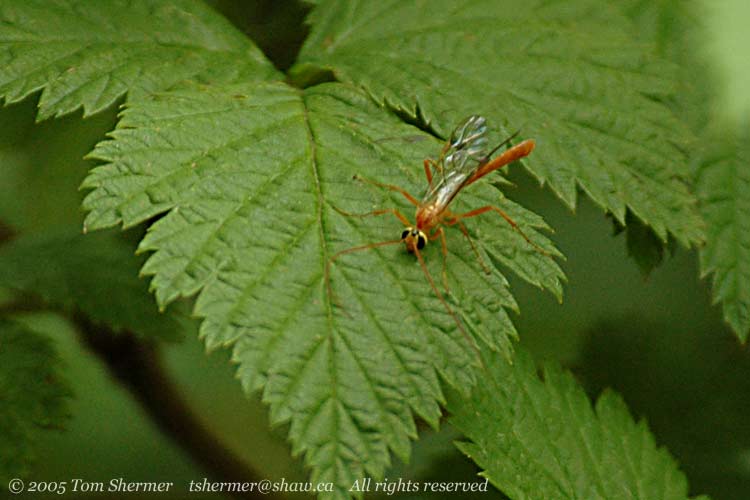 |
|
That critter turns
out to be some sort of Ichneumon, which, depending on your perspective,
is either a wasp or closely related to a wasp. These guys don't
sting, and are a solitary rather than social animal (there are
no big Ichneumon nests like wasp nests). The ichneumon pictured
here is some sort of Short-tailed Ichneumon, but I don't know
the exact species. Long-tailed Ichneumons have tails that are
longer than their antennae.
When the ichneumon
flew off, I headed on. A few minutes later, I found a Rufous Hummingbird
perched on a bare branch near the trail. He posed for me for a
while.
|
|
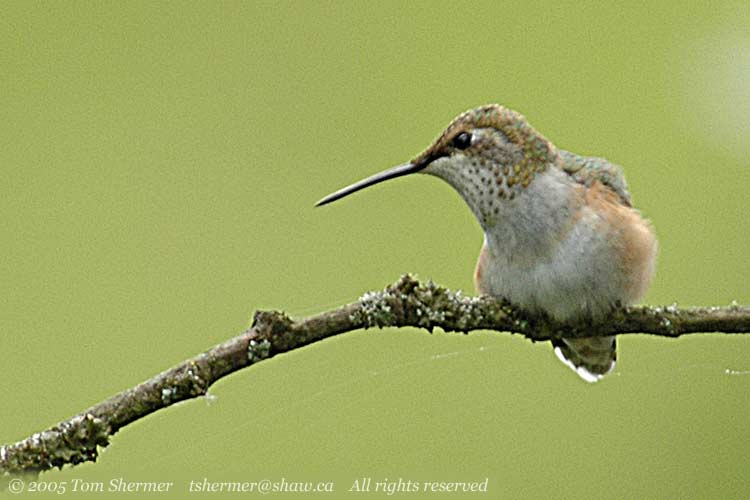 |
|
The redstart had been
reported to be at a particular place on the nature dyke, and,
despite looking carefully when I came to that place, I didn't
find him. I made it out to the observation tower with no further
encounters.
I climbed up the tower
and took some photos of the acquatic plants growing in the adjacent
slough. Here's my favorite shot of them, including some leaves
floating on the surface of the water.
|
|
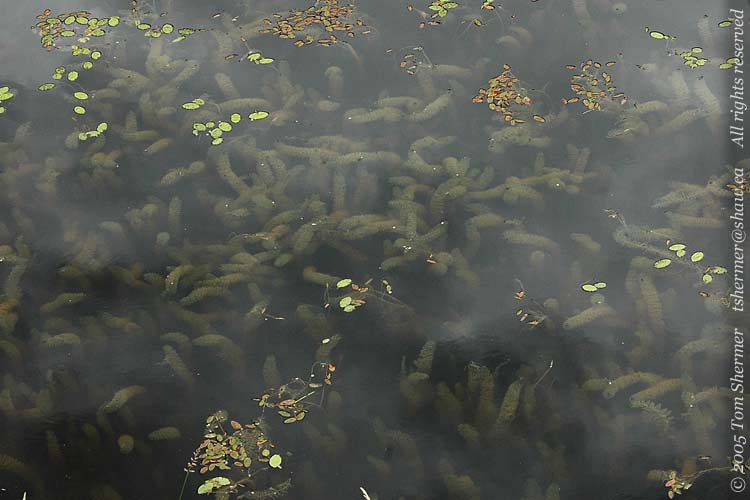 |
| I had my
wide-angle lens with me, and I used it to take this shot showing
both the slough and the base of the tower. |
|
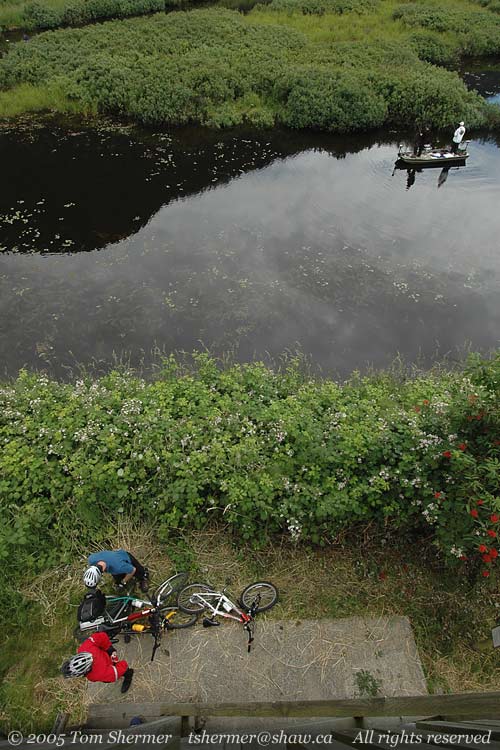 |
|
I like the way that
shot simultaneously shows people from the top and from the side...that's
the kind of cool stuff that you can do with a wide-angle but not
with a telephoto.
And of course, wide-angle
is also good for landscape. This is a shot to the southeast, from
the tower.
|
|
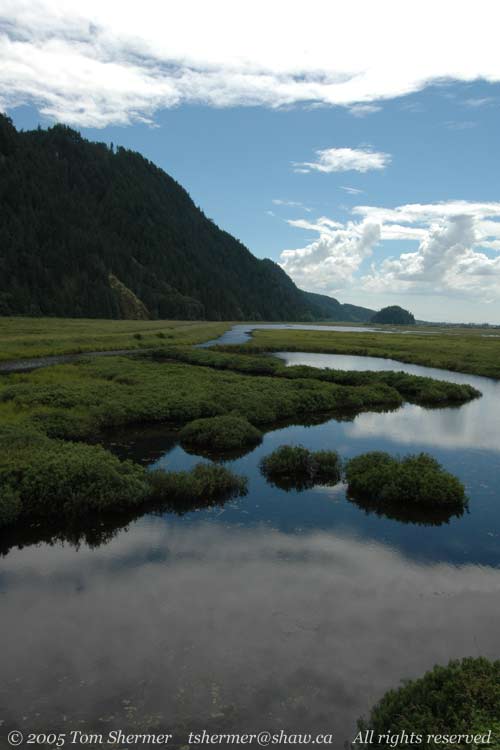 |
| There were
a pair of people on the trail near the tower who were also looking
for the oriole. As I walked out towards them, we all heard a loud
bird call. It was our target; this bird was not shy. We looked around
and eventually found him up in a Cottonwood. |
|
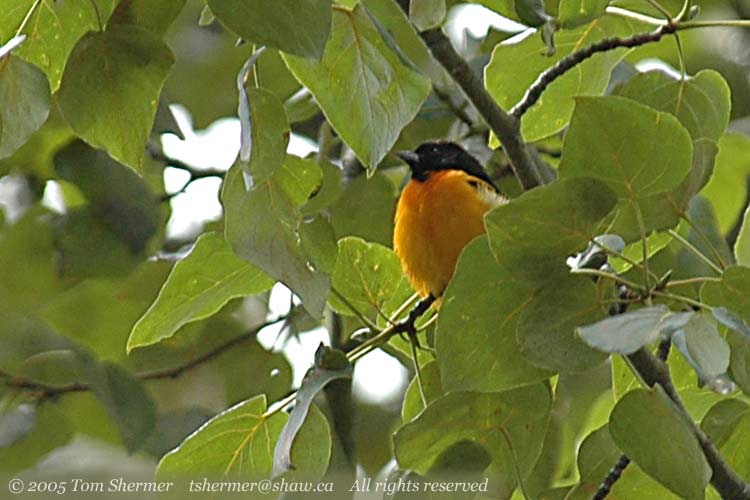 |
|
The Baltimore Oriole
is not a regular inhabitant or visitor here; the closest that
it normally comes is east of the Rockies over in Alberta. This
bird is an adult male. Our local oriole is the Bullock's Oriole,
which, compared to the guy above, would have orange on the face
and more white on the wings.
As the oriole continued
its loud calling, it flew once or twice, and I eventually found
myself on the sunward side of him with a little bit of a line
of sight. Sadly, he never got to a place where I could get a photo
that was completely unobscured by leaves.
|
|
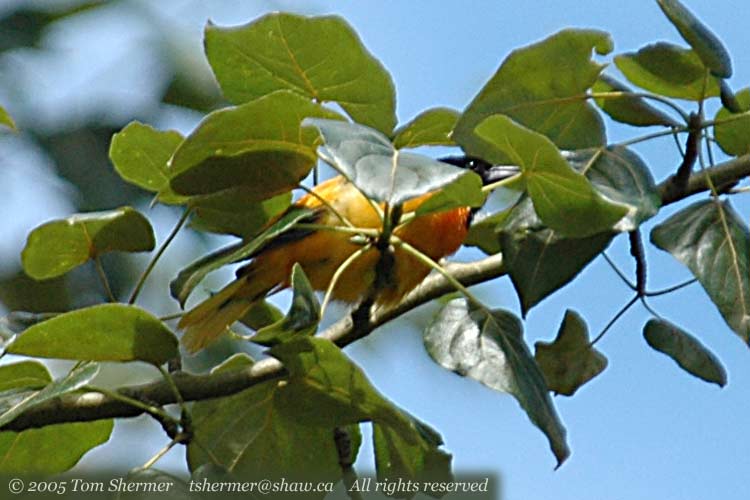 |
|
After watching and
listening to the oriole for a while, I moved on. There was a woodpecker
working the area; I had first spotted him from the tower when
he was foraging in the berry bushes near the base. I saw him there
again after leaving the oriole, so I set up to see if I could
get a good photo.
It turns out that my
woodpecker had some pretty regular habits, and was returning to
the base of the tower quite frequently. He also seemed fairly
accustomed to people being around, and didn't have a problem with
perching near me. Here he is, on one of the tower supports.
|
|
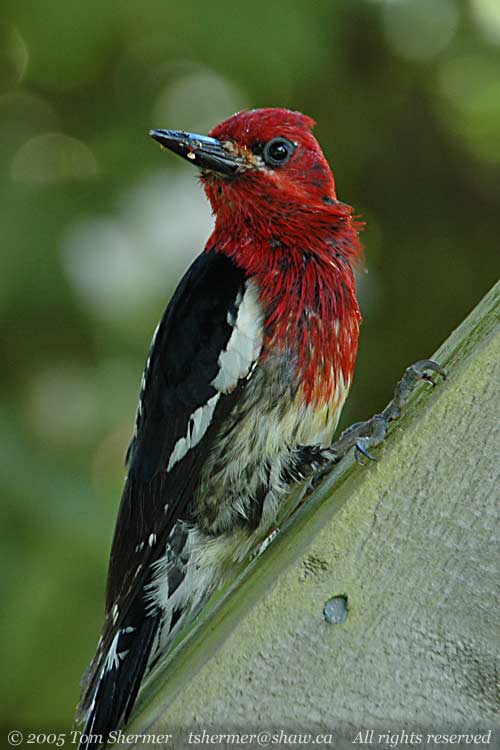 |
| He's a Red-breasted
Sapsucker, the same kind of woodpecker I had seen at Burnaby Lake
the week before. I got several close pictures of him, but few in
full sunlight. Here's one of the sunlight photos, where he's gripping
a tower support from the underside. |
|
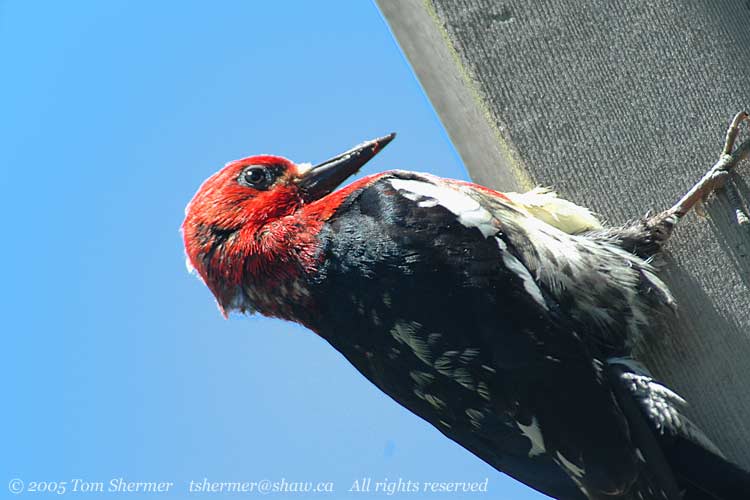 |
|
He flew over to the
berry bushes for a little while, and then flew away; I suspect
that he was gathering food for his children.
Right next to the base
of the tower, I found a Potter Wasp. I like this photo because
it shows the wasp's pedicel, which is the thin connector
between its abdomen and thorax. It's amazing that they have two
big parts like that connected by such a thin, fragile-looking
thing.
|
|
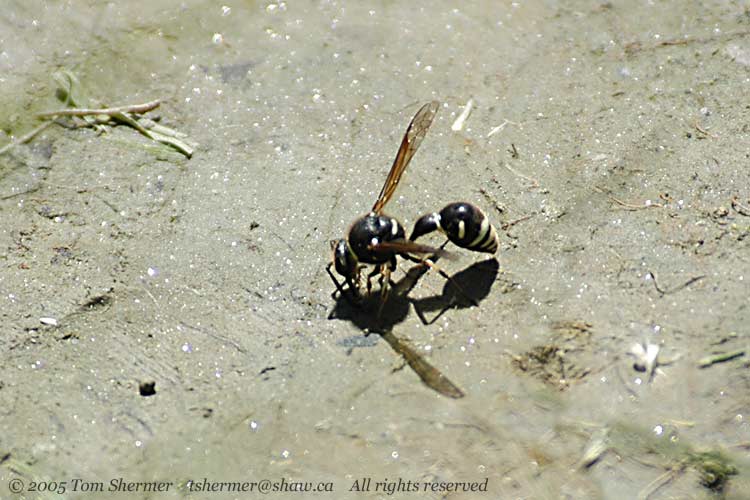 |
|
I walked a little ways
north, away from the nature dyke. I was a little shocked to notice
a coworker of mine, Petra, coming down the trail with her two
dogs. She was out of context for me; normally I see her in the
halls at work. We chatted briefly, but she was intent on her walk
and soon was on her way.
There were several
dragonflies buzzing around and I decided to work on dragonfly
photos for a while. I tried to get some flight photos, but just
didn't seem to be able to get the camera focussed quickly enough
and so I struck out there. I found a few dragonflies that had
perched, though, such as this Skimmer that I can't identify.
|
|
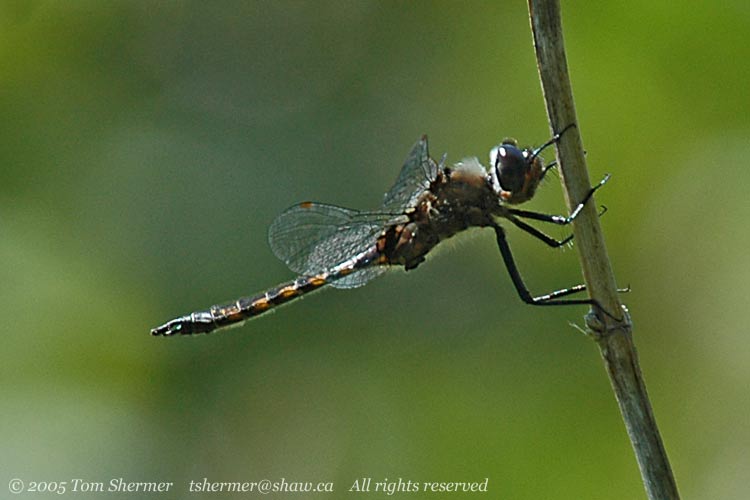 |
|
The next dragonfly
that I found, though, I could identify. It was a Four-spotted
Skimmer. Not only that, but this skimmer reminded me of something
that I learned as a child, but had forgotten: ladybugs taste good.
|
|
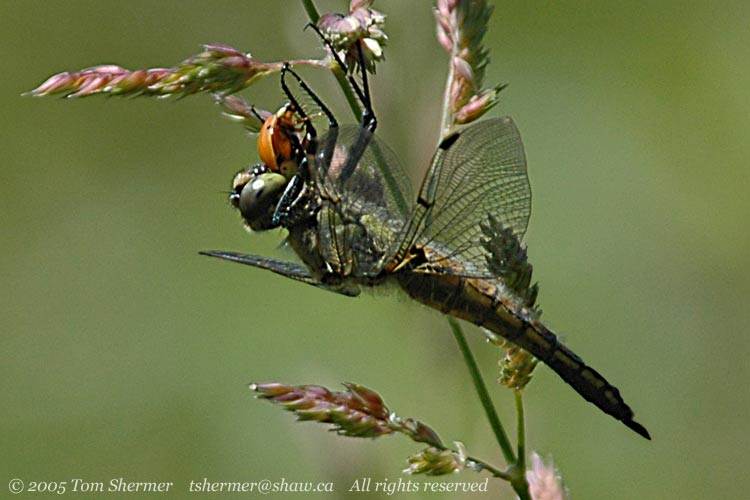 |
|
Although
now I'd call them Ladybird Beetles, not ladybugs.
Here's a shot showing
more of the markings of a Four-spotted Skimmer. It's named for
the four spots at the front of each pair of wings. It also has
a black triangular spot at the base of each hindwing.
|
|
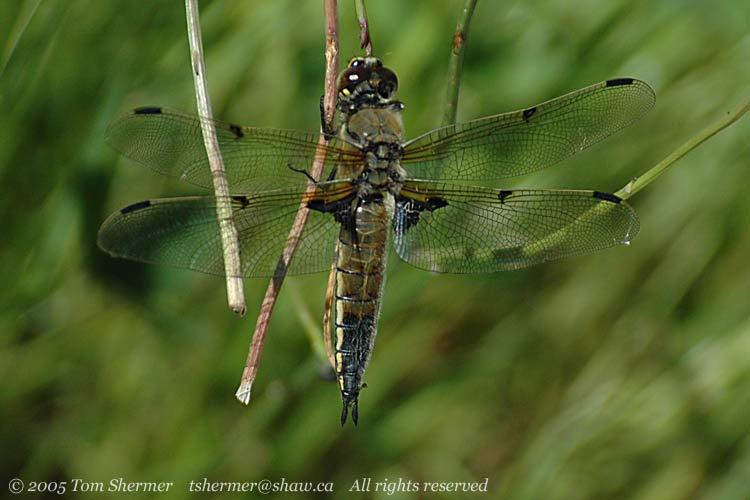 |
| I looked
up when I saw some red going by, and saw the sapsucker land and
perch on the side of a tree. Then he went on in; that hole to the
right of his head is his home. |
|
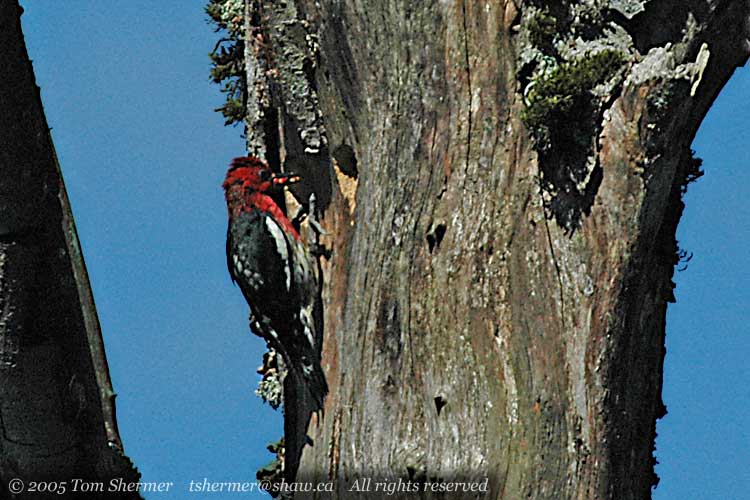 |
|
After watching him
disappear, I turned and headed back the way I came. The sapsucker
flew past me one more time on my way back to the nature dyke.
I had almost made it
back to the dyke when I stopped to shoot a Painted Lady that I
had seen on the berry brambles. I got several interesting photos,
including one of the lady in flight.
|
|
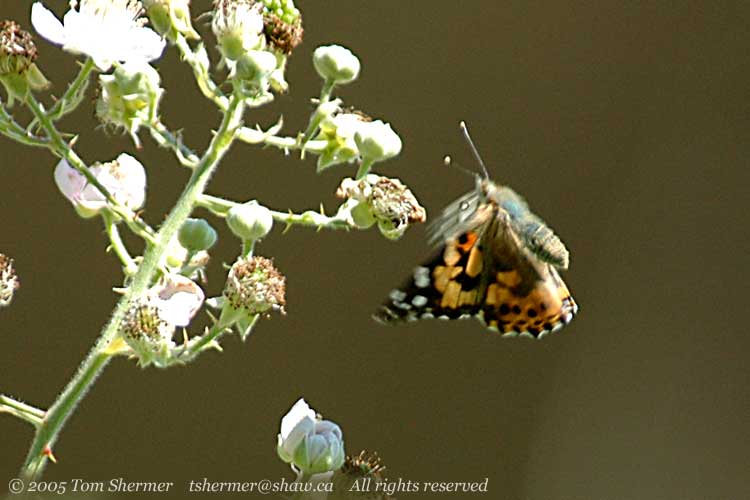 |
| When it
landed, I managed to get some good close-ups. This one shows the
insect's curly tongue. |
|
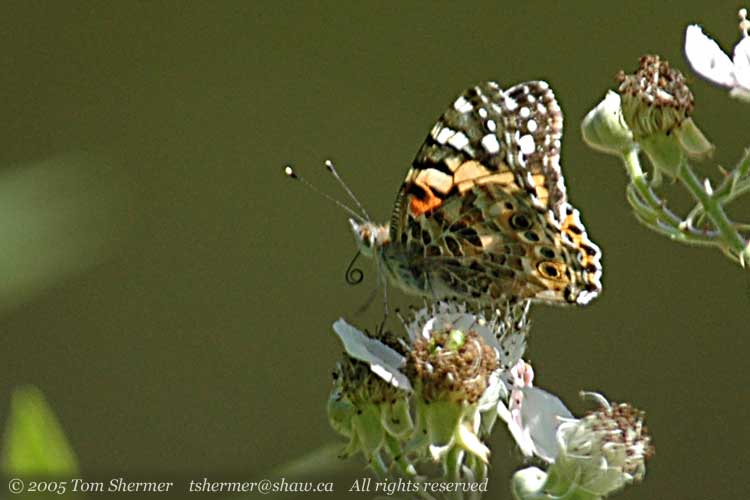 |
| That was
weird...butterfly tongue. It's enough to make you want to take off
your head and give it a shake. |
|
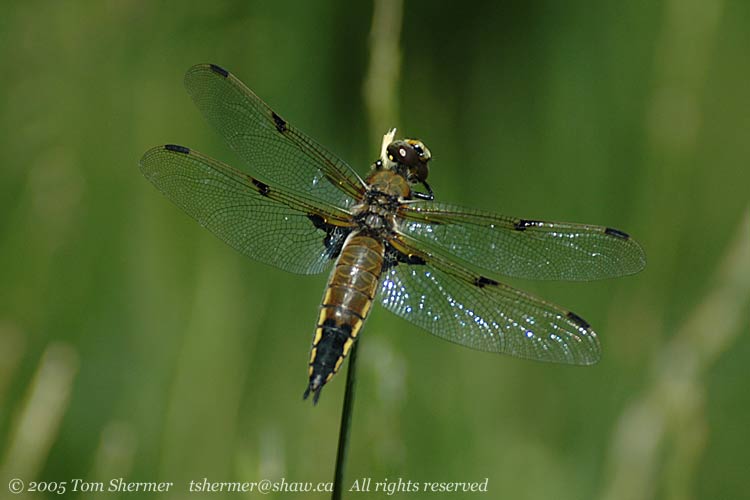 |
| I noticed
some movement on my left, and followed it to a flycatcher. I trailed
him for a little ways before getting a decent camera angle. It was
an Eastern Kingbird, one of our big flycatchers. |
|
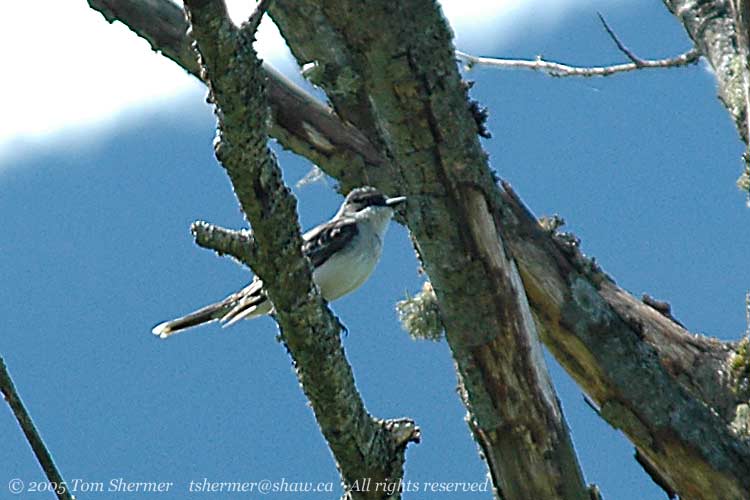 |
| Following
the kingbird had led me away from the dyke; when I got back to it,
there was another kind of dragonfly on the gravel beside the tower.
It was a female Common Whitetail. It may seem poorly-named, but
the males really do have white tails. |
|
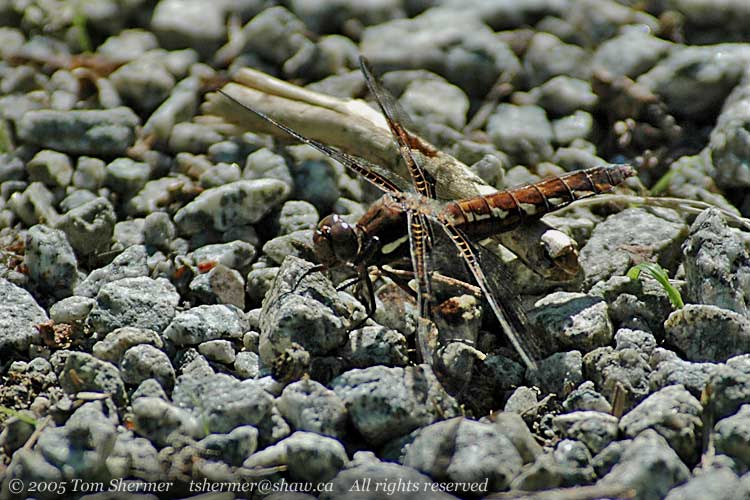 |
|
Vancouver is at the
northern edge of this species' range.
I finally made it back
to the dyke, but just a couple of minutes in I spotted a Western
Tiger Swallowtail, our local tiger. He had his wings all spread
out in the sun.
|
|
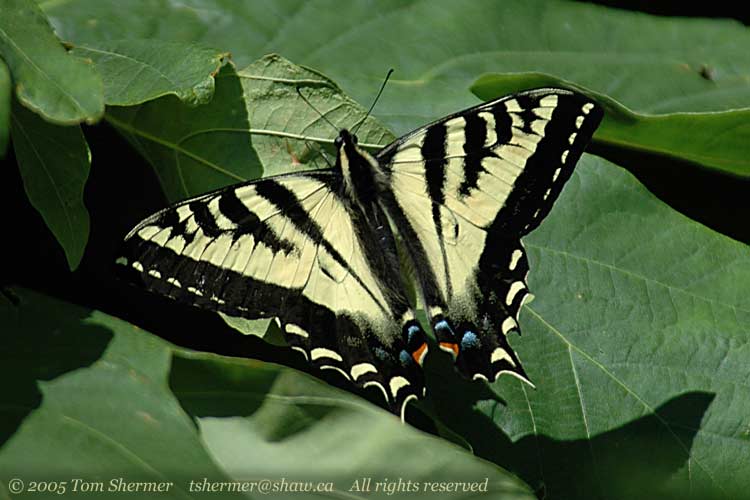 |
|
Nearby I found a red-eyed
damselfly on a berry stalk. I couldn't get around the stalk for
a shot from the other side.
|
|
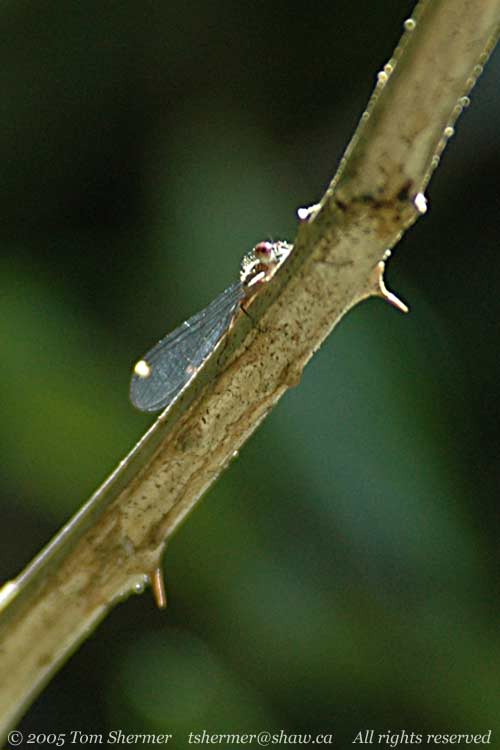 |
| After a
few more minutes of walking, I spot another Painted Lady. This one
I was able to get quite close to, and I'll be danged if she didn't
go and stick her tongue out at me. |
|
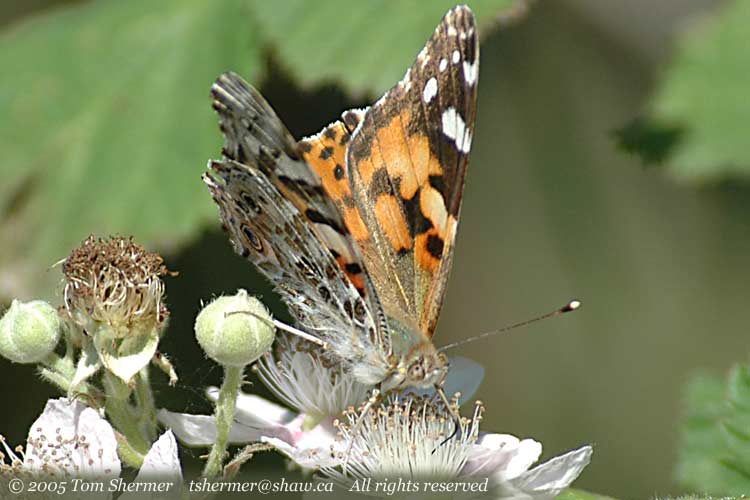 |
| At the same
location, there was a honeybee on another berry flower, and even
he got into the act. |
|
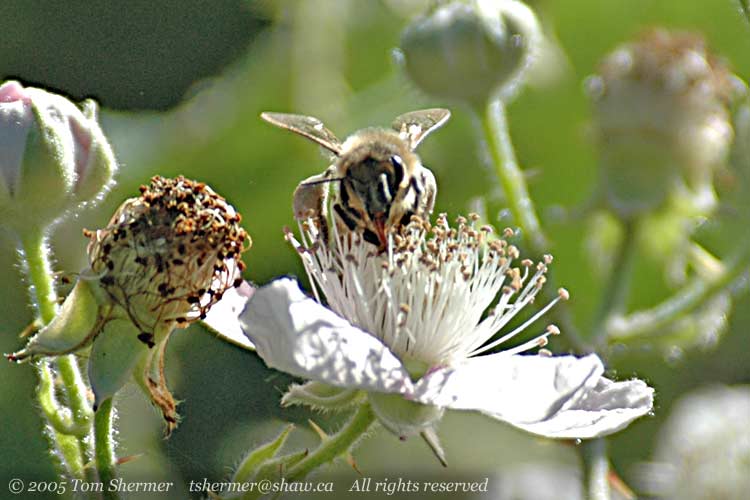 |
|
Maybe the universe
is trying to send me a message. What does it mean when insects
start sticking their tongue out at you?
My next encounter was
with bird with a sturdy bill. In the field, I saw only the bird's
silhouette; I've brought up the dark parts quite a bit in Photoshop.
There's enough detail here to show that the bird was a female
Black-headed Grosbeak.
|
|
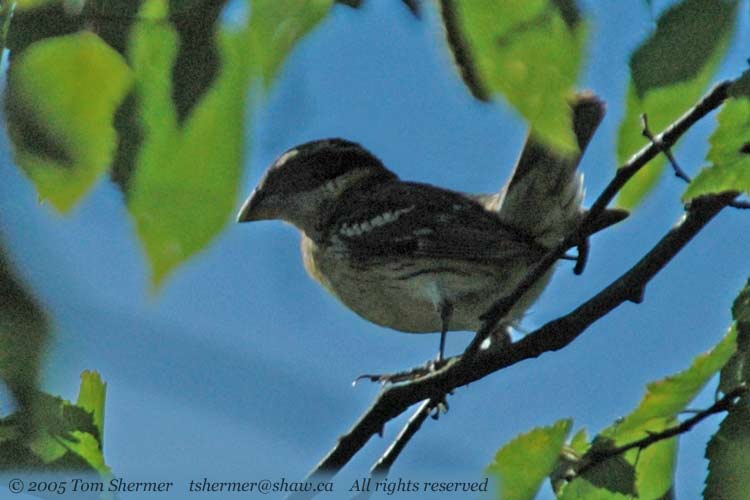 |
|
As I continued walking
down the dyke, I occasionally saw a few fast, small, yellow birds
flush from the bushes and trees beside me. Most of them were Yellow
Warblers, and I got a few photos of them, but nothing that interesting.
However, one of those
little yellow things wasn't quite a Yellow Warbler. At first I
thought it was, but as I was scrambling to get a few photos of
it, I noticed that a few things looked odd. Here's my bird.
|
|
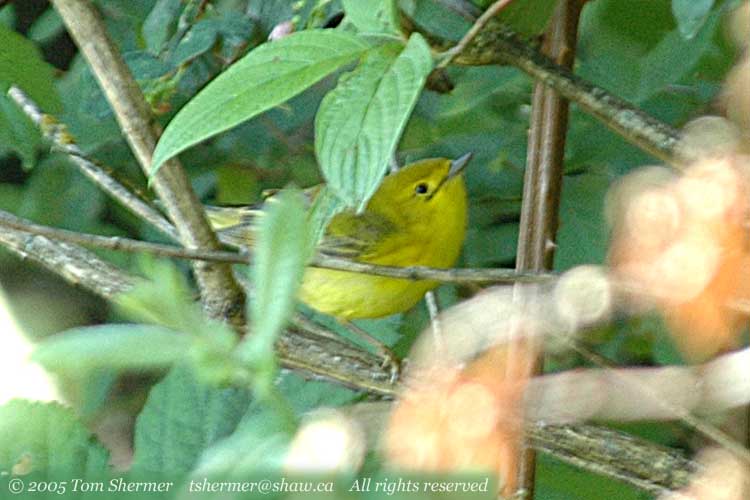 |
|
It looks a lot like
a Yellow Warbler, but that black line back from his bill to under
his eye is strange. There also seems to be only a hint of red
streaking around his "armpit", and his back and wings
have a fair amount of grey on them. Those markings are not very
Yellow Warbler-like.
Here's a shot of him
from the front, which shows the underside of his tail. Undertail
markings are often very helpful in identifying a bird.
|
|
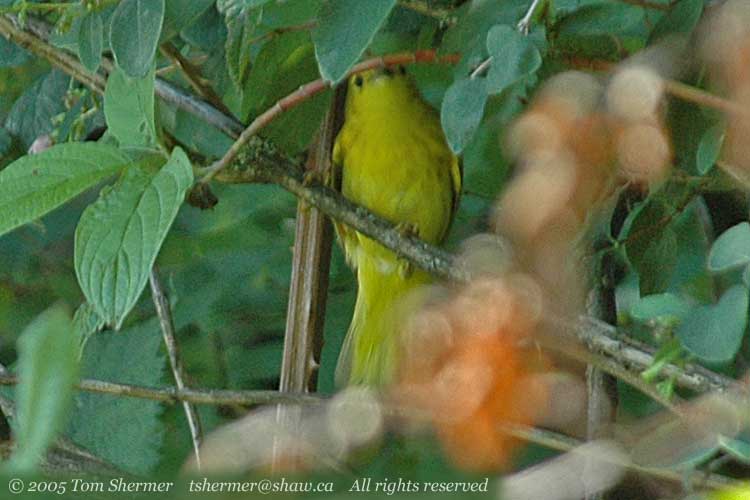 |
|
But not this bird:
that's just a typical Yellow Warbler undertail. I've shown my
photos around, and had them looked at by experts, but nobody has
identified this bird. It is most probably a hybrid warbler, a
cross between a Yellow Warbler and something else, but no-one
has figured out what the something else is. It's a biological
mystery.
For comparison, here's
a standard Yellow Warbler that I was able to catch a photo of
later in my walk. Bright and happy little fellow, he is.
|
|
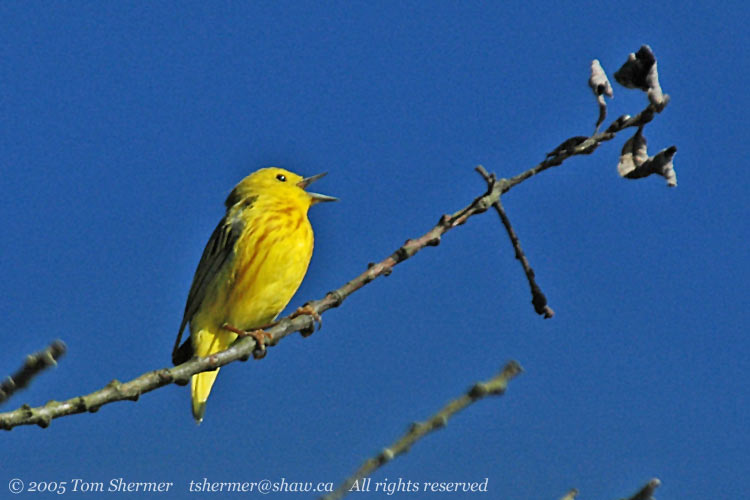 |
|
After that little bit
of excitement, I almost forgot to check for the American Redstart
on my way back. But I didn't forget, as a little plank bridge
in the trail reminded me.; the bridge was near where the bird
had been seen.
So I looked again for
the redstart, with no luck. The only interesting thing I found
in the area was a big mushroom up on a tree.
|
|
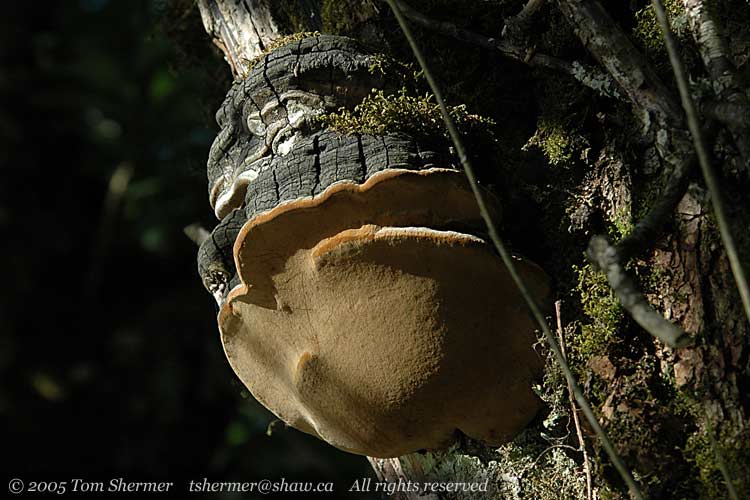 |
|
I really liked its
shape for some reason.
It was now only a short
walk back to the boat ramp and parking lot, but I saw a few more
things on this last leg. There were a few Cedar Waxwings about,
flying from tree to tree. Here I caught one curling his body into
a crescent shape.
|
|
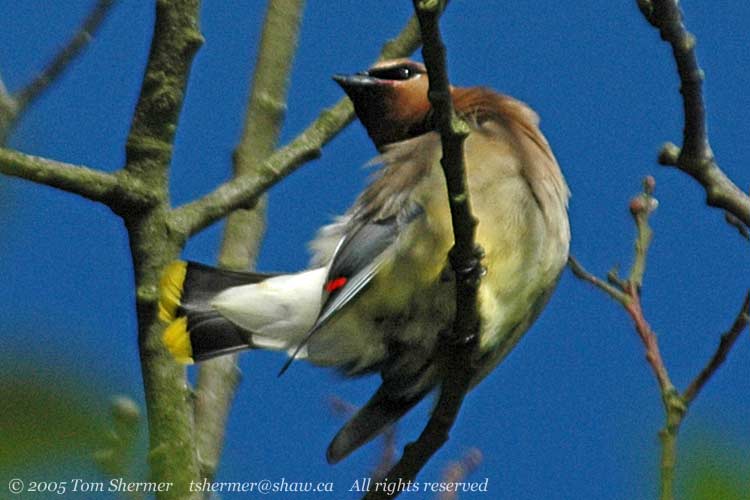 |
|
I don't know why that
photo turned out so grainy, but it did.
Past the end of the
trail, I found a couple of damselflies on a tree limb.
|
|
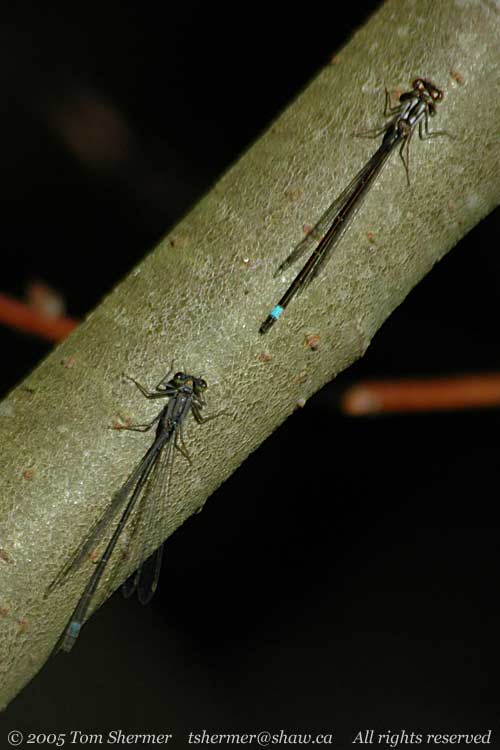 |
|
And then I caught a
Spotted Towhee up in another tree. I like the towhee's bright
red eyes.
|
|
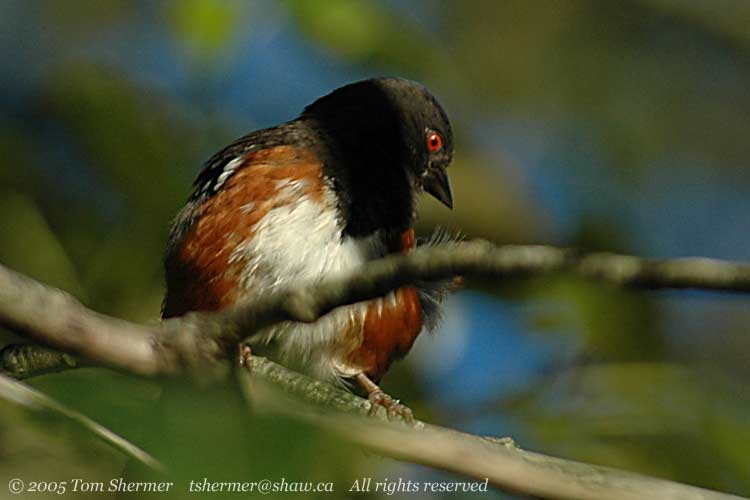 |
|
I was pretty tired
by this point and gratefully collapsed into my car and drank a
bottle of water. I headed back towards home, but I stopped once
when I spotted some swallows on a wire. One of them was a Cliff
Swallow, and he was my first Cliff of the season.
|
|
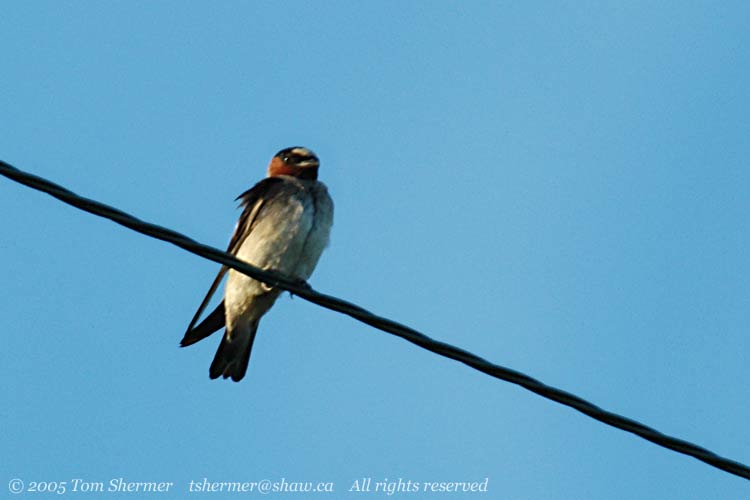 |
|
I was happy to see
him; I like Cliffs' coloration (and nest-building habits) and
had been looking for them at several places lately. I'd heard
reports of them being around, but it was nice to see with my own
eyes.
Still puzzling over
insect tongue,
Tom
|
|